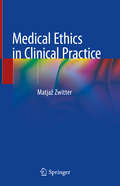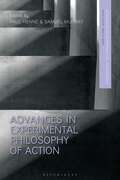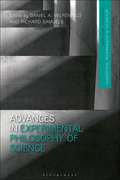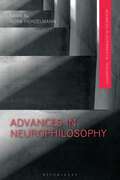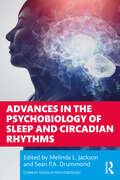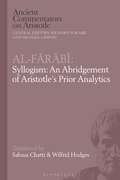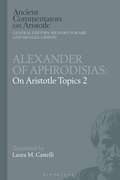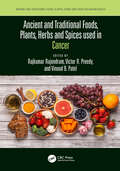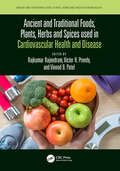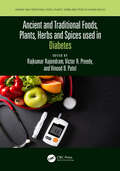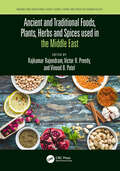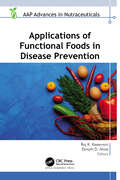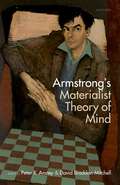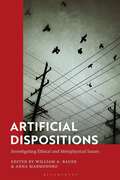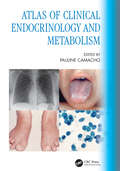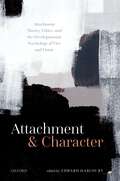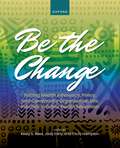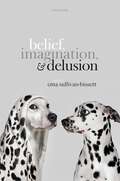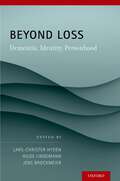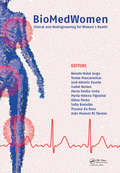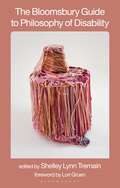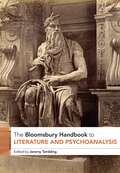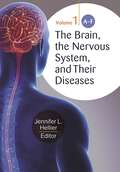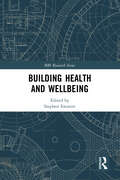- Table View
- List View
Medical Ethics in Clinical Practice
by Matjaž ZwitterThis book discusses medicine from an ethical perspective, whereas books on medical ethics more commonly present ethics from a bio-medical standpoint. The book is divided into 23 chapters. The introductory chapters present some basic concepts of medical ethics, such as the relation between the legal system and ethics, ethical documents, ethical theories, and ethical analysis. The following chapters address issues of importance in all fields of medicine: respecting autonomy, communication, relations within a healthcare team, professional malpractice, limited resources, and the portrait of a physician. In turn, the third part of the book focuses on ethical aspects in a broad range of medical activities – preventive medicine, human reproduction, genetics, pediatrics, intensive care, palliative medicine, clinical research, unproven methods in diagnostics and treatment, and the role of physicians who aren’t directly responsible for patient care. The last part presents students’ seminars with case stories. The book offers a valuable resource for physicians of all specialties, students of medicine, professionals, and students from other fields devoted to human health, journalists, and general readers with an interest in medicine.
Acquaintance: New Essays
Bertrand Russell famously distinguished between 'knowledge by acquaintance' and 'knowledge by description'. For much of the latter half of the twentieth century, many philosophers viewed the notion of acquaintance with suspicion, associating it with Russellian ideas that they would wish to reject. However in the past decade or two the concept has undergone a striking revival in mainstream 'analytic' philosophy—acquaintance is, it seems, respectable again. This volume showcases the great variety of topics in philosophy of mind, epistemology, and philosophy of language for which philosophers are currently employing the notion of acquaintance. It is the first collection of new essays devoted to the topic of acquaintance, featuring chapters from many of the world's leading experts in this area. Opening with an extensive introductory essay, which provides some historical background and summarizes the main debates and issues concerning acquaintance, the remaining thirteen contributions are grouped thematically into four sections: phenomenal consciousness, perceptual experience, reference, and epistemology.
Advances in Experimental Philosophy of Action (Advances in Experimental Philosophy)
What is self-control? Does a person need to be conscious to act? Are delusions always irrational? Questions such as these are fundamental for investigations into action and rationality, as well as how we assign responsibility for wrongdoing and assess clinical symptoms. Bridging the gap between philosophy and psychology, this interdisciplinary collection showcases how empirical research informs and enriches core questions in the philosophy of action.Exploring issues such as truth, moral judgement, agency, consciousness and cognitive control, chapters offer an overview of the current state of research, present new empirical findings and identify where future experimental work can further advance the frontier between philosophy and psychology. This is an essential resource for anyone looking to better understand how science and philosophy can meaningfully inform our knowledge of human agency.
Advances in Experimental Philosophy of Science (Advances in Experimental Philosophy)
This volume gathers together leading philosophers of science and cognitive scientists from around the world to provide one of the first book-length studies of this important and emerging field. Specific topics considered include learning and the nature of scientific knowledge, the cognitive consequences of exposure to explanations, climate change, and mechanistic reasoning and abstraction. Chapters explore how experimental methods can be applied to questions about the nature of science and show how to fruitfully theorize about the nature and role of science with well-grounded empirical research. Advances in Experimental Philosophy of Science presents a new direction in the philosophical exploration of science and paves a path for those who might seek to pursue research in experimental philosophy of science.
Advances in Neurophilosophy (Advances in Experimental Philosophy)
Bringing together recent case studies and insights into current developments, this collection introduces philosophers to a range of experimental methods from neuroscience. Chapters provide a comprehensive survey of the discipline, covering neuroimaging such as EEG and MRI, causal interventions like brain stimulation, advanced statistical methods, and approaches drawing on research into the development of human individuals and humankind. A team of experts combine clear explanations of complex methods with reports of cutting-edge research, advancing our understanding of how these tools can be applied to further philosophical inquiries into agency, emotions, enhancement, perception, personhood and more. With contributions organised by neuroscientific method, this volume provides an accessible overview for students and scholars coming to neurophilosophy for the first time, presenting a range of topics from responsibility to metacognition.
Advances in the Psychobiology of Sleep and Circadian Rhythms (Current Issues in Psychobiology)
Advances in the Psychobiology of Sleep and Circadian Rhythms features international experts from the fields of psychobiology, sleep research and chronobiology to address and review cutting-edge scientific literature concerning recent advances in the psychobiology of sleep, sleep disorders, such as sleep apnoea and insomnia, and circadian rhythms, across the lifespan. In this illuminating volume, Melinda L. Jackson and Sean P.A. Drummond bring together leading international researchers to review cross-cutting issues in the field, including sleep and pain, sleep and dementia risk, and sleep issues in paediatric populations as well as the interaction between sleep and health conditions in different populations. The chapters offer coverage of the major explanatory models which underpin the empirical work as well as a discussion of the relevant theoretical and conceptual models on issues arising with specific psychiatric and medical disorders, including depression, dementia, posttraumatic stress disorder and pain. They also address new research in the area of chronobiology, and circadian impacts on health and diseases. The chapters also discuss important methodological and ethical issues arising in research and include sections addressing implications for public policy and practitioner interventions in the context of different social and cultural environments. This volume will be a crucial resource for professionals, practitioners and researchers engaged in the field as well as for postgraduate and upper-level undergraduate students undertaking research in areas related to psychobiology, neuropsychology, health psychology and other disciplines such as biology, physiology and psychopharmacology.
Al-Farabi, Syllogism: An Abridgement of Aristotle’s Prior Analytics (Ancient Commentators on Aristotle)
The philosopher Abu Nasr al-Farabi (c. 870-c. 950 CE) is a key Arabic intermediary figure. He knew Aristotle, and in particular Aristotle's logic, through Greek Neoplatonist interpretations translated into Arabic via Syriac and possibly Persian. For example, he revised a general description of Aristotle's logic by the 6th century Paul the Persian, and further influenced famous later philosophers and theologians writing in Arabic in the 11th to 12th centuries: Avicenna, Al-Ghazali, Avempace and Averroes. Averroes' reports on Farabi were subsequently transmitted to the West in Latin translation. This book is an abridgement of Aristotle's Prior Analytics, rather than a commentary on successive passages. In it Farabi discusses Aristotle's invention, the syllogism, and aims to codify the deductively valid arguments in all disciplines.He describes Aristotle's categorical syllogisms in detail; these are syllogisms with premises such as 'Every A is a B' and 'No A is a B'. He adds a discussion of how categorical syllogisms can codify arguments by induction from known examples or by analogy, and also some kinds of theological argument from perceived facts to conclusions lying beyond perception. He also describes post-Aristotelian hypothetical syllogisms, which draw conclusions from premises such as 'If P then Q' and 'Either P or Q'. His treatment of categorical syllogisms is one of the first to recognise logically productive pairs of premises by using 'conditions of productivity', a device that had appeared in the Greek Philoponus in 6th century Alexandria.
Alexander of Aphrodisias: On Aristotle Topics 2 (Ancient Commentators on Aristotle)
Aristotle's Topics is a handbook for dialectic, which can be understood as a philosophical debate between a questioner and a respondent. In book 2, Aristotle mainly develops strategies for making deductions about 'accidents', which are properties that might or might not belong to a subject (for instance, Socrates has five fingers, but might have had six), and about properties that simply belong to a subject without further specification.In the present commentary, here translated into English for the first time, Alexander develops a careful study of Aristotle's text. He preserves objections and replies from other philosophers whose work is now lost, such as the Stoics. He also offers an invaluable picture of the tradition of Aristotelian logic down to his time, including innovative attempts to unify Aristotle's guidance for dialectic with his general theory of deductive argument (the syllogism), found in the Analytics.The work will be of interest not only for its perspective on ancient logic, rhetoric, and debate, but also for its continuing influence on argument in the Middle Ages and later.
Ancient and Traditional Foods, Plants, Herbs and Spices used in Cancer (Ancient and Traditional Foods, Plants, Herbs and Spices in Human Health)
The use of different foods, herbs, and spices to treat or prevent disease has been recorded for thousands of years. Egyptian papyrus, hieroglyphics and ancient texts from the Middle East have described the cultivation and preparations of herbs and botanicals to “cure the sick.” There are even older records from China and India. Some ancient scripts describe the use of medicinal plants which have never been seen within European cultures. Indeed, all ancient civilizations have pictorial records of different foods, herbs, and spices being used for medical purposes. However, there are fundamental questions pertaining to the scientific evidence for the use of these agents or their extracts in modern medicine. There have been considerable advances in scientific techniques over the last few decades. These have been used to examine the composition and applications of traditional cures. Modern science has also seen the investigation of herbs, spices and botanicals beyond their traditional usage. For example, plants which have been used for “digestion” or “medical ills” since time immemorial are now being investigated for anti-cancer properties or their toxicity, using high throughput screening. Techniques also include molecular biology, cellular biochemistry, physiology, endocrinology and even medical imaging. However, much of the material relating to the scientific basis or applications of traditional foods, herbs, spices and botanicals is scattered among various sources. The widespread applicability of foods or botanicals is rarely described and cautionary notes on toxicity are often ignored. These questions are explored in Ancient and Traditional Foods, Plants, Herbs and Spices used in Cancer. Features · Provides an evidenced-based approach in describing usage and applications of traditional foods and botanicals in prevention and treatment of cancer · Contains chapters on biomedical research related to cancer studies · Discusses extraction and analysis of active agents, in vitro studies, pre-clinical investigations in animals, and clinical studies · Bridges modern day sciences with historical backgrounds related to foods and plants With contributions from leading international experts including those from world renowned institutions, this book is a reference for oncologists, physicians, health scientists, healthcare workers, pharmacologists, and research scientists.
Ancient and Traditional Foods, Plants, Herbs and Spices used in Cardiovascular Health and Disease (Ancient and Traditional Foods, Plants, Herbs and Spices in Human Health)
The use of different foods, herbs, and spices to treat or prevent disease has been recorded for thousands of years. Egyptian papyrus, hieroglyphics and ancient texts from the Middle East have described the cultivation and preparations of herbs and botanicals to "cure the sick". There are even older records from China and India. Some ancient scripts describe the use of medicinal plants which have never been seen within European cultures. Indeed, all ancient civilizations have pictorial records of different foods, herbs, and spices being used for medical purposes. However, there are fundamental issues pertaining to the scientific evidence for the use of these agents or their extracts in modern medicine. There have been considerable advances in scientific techniques over the last few decades. These have been used to examine the composition and applications of traditional cures. Modern science has also seen the investigation of herbs, spices and botanicals beyond their traditional usage. For example, plants which have been used for “digestion” or “medical ills” since time immemorial are now being investigated for anti-cancer properties or their toxicity, using high throughput screening. Techniques also include molecular biology, cellular biochemistry, physiology, endocrinology and even medical imaging. However, much of the material relating to the scientific basis or applications of traditional foods, herbs, spices and botanicals is scattered among various sources. The widespread applicability of foods or botanicals are rarely described and cautionary notes on toxicity are often ignored. These issues are explored in Ancient and Traditional Foods, Plants, Herbs and Spices used in Cardiovascular Health and Disease. Features: Investigates alternative healthcare paradigms that use traditional dietary foods, plant-derived materials, and extracts to treat cardiovascular diseases Provides information on diets, specific agents, and extracts Many chapters focus on plant-derived material, providing a historical background, uses, toxicity and cautionary notes and summary points With contributions from leading international experts, this book is useful for cardiologists, nutritionists, physicians, healthcare workers, food scientists and those working in the food industry, pharmacologists, and research scientists.
Ancient and Traditional Foods, Plants, Herbs and Spices used in Diabetes (Ancient and Traditional Foods, Plants, Herbs and Spices in Human Health)
The use of different foods, herbs, and spices to treat or prevent disease has been recorded for thousands of years. Egyptian papyrus, hieroglyphics and ancient texts from the Middle East have described the cultivation and preparations of herbs and botanicals to “cure the sick.” There are even older records from China and India. Some ancient scripts describe the use of medicinal plants which have never been seen within European cultures. Indeed, all ancient civilizations have pictorial records of different foods, herbs, and spices being used for medical purposes. However, there are fundamental issues pertaining to the scientific evidence for the use of these agents or their extracts in modern medicine. These issues are explored in Ancient and Traditional Foods, Plants, Herbs and Spices Used in Diabetes. Features · Investigates alternative healthcare paradigms that use traditional dietary foods, plant-derived materials, and extracts to treat diabetes · Describes scientific studies using modern day biomedical techniques · Provides information on diets, specific agents, extracts and resources. · Many chapters focus on plant-derived material, providing a historical background, uses, toxicity, and cautionary notes and summary points. There have been considerable advances in scientific techniques over the last few decades. These have been used to examine the composition and applications of traditional cures. Modern science has also seen the investigation of herbs, spices and botanicals beyond their traditional usage. Diabetes is one of the most common diseases worldwide, with over 400 million people with the illness. With chapter contributions by an international panel of contributors, this book is useful for researchers in the area of functional foods. Diabetologists, nutritionists, endocrinologists, healthcare workers, and pharmacologists will also find this book extremely valuable.
Ancient and Traditional Foods, Plants, Herbs and Spices used in the Middle East (Ancient and Traditional Foods, Plants, Herbs and Spices in Human Health)
The use of different foods, herbs, and spices to treat or prevent disease has been recorded for thousands of years. Egyptian papyrus, hieroglyphics and ancient texts from the Middle East have described the cultivation and preparations of herbs and botanicals to “cure the sick.” There are even older records from China and India. Some ancient scripts describe the use of medicinal plants which have never been seen within European cultures. Indeed, all ancient civilizations have pictorial records of different foods, herbs, and spices being used for medical purposes. However, there are fundamental questions and issues pertaining to the scientific evidence for the use of these agents or their extracts in modern medicine. These issues are explored in Ancient and Traditional Foods, Plants, Herbs and Spices used in the Middle East. Features · Describes uses and applications of plant-based materials from different countries of the Middle East. · Each chapter has unique cross references to foods, herbs, spices and botanicals · Bridges molecular biology, physiology and medical sciences · Coverage includes herbal medicines, supplements, lifestyle patterns, nutrition, and plant-based diets · Each chapter describes usage and applications of traditional foods and botanicals; historical background; toxicity; cautionary notes; and summary points There have been considerable advances in scientific techniques over the last few decades. These have been used to examine the composition and applications of traditional cures. Modern science has also seen the investigation of herbs, spices and botanicals beyond their traditional usage. Written by international experts, this is an essential read for food researchers, food scientists, and nutritionists, researchers and health professionals with an interest in the potential therapeutic value of Middle Eastern food components. The book will also be of relevance to physicians and pharmacologists.
Applications of Functional Foods in Disease Prevention (AAP Advances in Nutraceuticals)
Functional food sources are growing in popularity because they are exceptionally nutritious and provide amazing medical advantages. They can help ensure against infection, prevent supplement deficiency, and advance appropriate health development and improvement. With illustrative case studies, this new volume explores the many roles of functional foods in the prevention and management of various diseases, including diabetes, autism spectrum disorder, weight loss and obesity, microbial infections, ulcers and other gastrointestinal diseases, mental disorders and brain health, cardiac health and cardiovascular diseases, osteoporosis and bone health, and more.
Armstrong's Materialist Theory of Mind
A Materialist Theory of Mind (1968) by David Armstrong is one of a handful of texts that began the physicalist revolution in the philosophy of mind. It is perhaps the most influential book in the field of the second half of the twentieth century. In this volume a distinguished international team of philosophers examine what we still owe to Armstrong's theory, and how to expand it, as well as looking back on how it came about. The first four chapters are historical in orientation, exploring how the book fits into the history of materialism in the twentieth century. The chapters that follow discuss perception, belief, the supposed explanatory gap between the physical and the mental, introspection, conation, causality, and functionalism.
Artificial Dispositions: Investigating Ethical and Metaphysical Issues
We inhabit a world not only full of natural dispositions independent of human design, but also artificial dispositions created by our technological prowess. How do these dispositions, found in automation, computation, and artificial intelligence applications, differ metaphysically from their natural counterparts? This collection investigates artificial dispositions: what they are, the roles they play in artificial systems, and how they impact our understanding of the nature of reality, the structure of minds, and the ethics of emerging technologies. It is divided into four parts covering the following interconnected themes: (i) Artificial and Natural Dispositions, (ii) Artificial Systems and Their Dispositions, (iii) Agency, Mind, and Artificial Dispositions, and (iv) Artificial Moral Dispositions. This is a groundbreaking and thought-provoking resource for any student or scholar of philosophy of science, contemporary metaphysics, applied ethics, philosophy of mind, and philosophy of technology.
Atlas of Clinical Endocrinology and Metabolism
This updated text is a pictorial atlas of endocrine and metabolic disorders. Each chapter focuses on providing multiple illustrations as well as a thorough discussion of the diagnosis and management of a variety of endocrine diseases with their appropriate treatment plans. Using updated guidelines, it provides a comprehensive discussion of the latest therapies, including diabetes technology. Presenting a large number of clinical images, including imaging of thyroid ultrasounds, DXA images, bone scans, and new technologies in diabetes mellitus, this atlas aims to provide the reader with the information needed to make accurate diagnoses, making it an updated source of highly illustrated information for endocrinologists, clinicians, residents, fellows and trainees. With new chapters on transgender medicine and obesity, this textbook is a valuable resource for the contemporary endocrine practitioner. • Features new chapters such as transgender medicine and inborn errors of metabolism • Aims to be an invaluable aid for endocrinologists, internal medicine specialists, family practice clinicians, residents, fellows, and trainees • Explores diabetes technology with updated guidelines
Attachment and Character: Attachment Theory, Ethics, and the Developmental Psychology of Vice and Virtue
There are many exciting points of contact between developmental psychology in the attachment paradigm and the kinds of questions first raised by Aristotle's ethics, and which continue to preoccupy moral philosophers today. The book brings experts from both fields together to explore them for the first time, to demonstrate why philosophers working in moral psychology, or in 'virtue ethics' - better, the triangle of relationships between the concepts of human nature, human excellence, and the best life for human beings - should take attachment theory more seriously than they have done to date. Attachment theory is a theory of psychological development. And the characteristics attachment theory is a developmental theory of - the various subvarieties of attachment - are evaluatively inflected: to be securely attached to a parent is to have a kind of attachment that makes for a good intimate relationship. But obviously the classification of human character in terms of the virtues is evaluatively inflected too. So it would be strange if there were no story to be told about how these two sets of evaluatively inflected descriptions relate to one another. Attachment and Character explores the relationship between attachment and prosocial behaviour; probes the concept of the prosocial itself, and the relationship between prosocial behaviour, virtue and the quality of the social environment; the question whether there even are such things as stable character traits; and whether attachment theory, in locating the origins of virtue in secure attachment, and attachment dispositions in human evolutionary history, gives support to ethical naturalism, in any of the many meanings of that expression.
Be the Change: Putting Health Advocacy, Policy, and Community Organization into Practice in Public Health Education
Advocacy has become a key part of public health degree programs across the country. Many programs have added policy and advocacy courses into curricula in response to new emphases in accreditation requirements, yet few public health textbooks comprehensively cover the advocacy skills that health professionals need to effect change. Be the Change is an affordable introductory resource on public health advocacy, policy, and community organizing for both undergraduate and graduate students within the health and social sciences. Using a conversational and reader-friendly style, the authors draw on their experience as diverse advocates and practitioners in the field to synthesize the purpose, strategies, and tactics used in successful advocacy campaigns in public health. In each chapter, they highlight case studies of actual advocacy campaigns alongside concrete strategic recommendations for implementing change at the local, state, and federal levels. Full of useful stories and advice, Be the Change amplifies the important advocacy work happening around the United States, from traditional health organizations to grassroots community activists, and provides readers with the tools and inspiration to put advocacy into practice every day.
Belief, Imagination, and Delusion (Mind Association Occasional Series)
This volume brings together recent work on the nature of belief, imagination, and delusion. Whilst philosophers of mind and epistemology employ notions of belief and imagination in their theorizing, parallel work seeking to make these notions more precise continues. Delusions are standardly taken to be bizarre beliefs occurring in the clinical population, which do not respond to evidence. The purpose of this collection of essays is to get clearer on the nature of belief and imagination, the ways in which they relate to one another, and how they might be integrated into accounts of delusional belief formation. The jumping off point is the idea that recent work in philosophy of mind and epistemology which has sought to characterize the nature of belief and imagination allows us to formulate the issues with new precision, by, for example, drawing on work concerning how imagination is involved in delusion formation, or work concerning how to properly distinguish imagination from belief. The volume also considers questions concerning imagination's architecture, the role of metacognitive error in our mental lives, how best to understand delusional experience, and the relationship between delusion and evidence. The contributors are ideally placed to explore these issues, both individually and as a collective. With interests spanning different disciplines (philosophy, psychology, cognitive science), and approaches (theoretical, empirically informed), the result is a rich and varied collection of insights.
Beyond Loss: Dementia, Identity, Personhood
Coming to terms with dementia is one of the great challenges of our time. This volume of new interdisciplinary essays by internationally established scholars offers new ways of understanding and dealing with it. It explores views of dementia that go beyond the idea of loss, and rather envisions it as multilayered transformation and change of personhood and identity, and as development that mostly is socially shared with others. The studies collected here identify new empirical, theoretical, and methodological areas that will be crucial to future research and clinical practice concerned with age-related dementia. Three general themes are singled out as of particular importance and interest: persons and personhood, identity and agency, and the social and the communal.
BioMedWomen: Proceedings of the International Conference on Clinical and BioEngineering for Women's Health (Porto, Portugal, 20-23 June, 2015)
BioMedWomen 2015 - Clinical and BioEngineering for Women´s Health contains all author contributions presented at BioMedWomen 2015 (Porto, Portugal, 20–23 June 2015). International contributions from countries worldwide provided comprehensive coverage of the current state-of-the-art on different topics: • Aging • Physical Activity and Sports • Physiotherapy • Aesthetic and Reconstructive Surgery • Urogynecology • Imaging • Biomechanics • Nutrition • Health Psychology • Assisted diagnosis and Treatment • Tissue Engineering • Medical Devices • Prosthesis • Dental care and Orthodontics BioMedWomen 2015 - Clinical and BioEngineering for Women´s Health will be of interest to academics and to others interested and involved in clinical and engineering subjects related to women´s health.
The Bloomsbury Guide to Philosophy of Disability
The Bloomsbury Guide to Philosophy of Disability is a revolutionary collection encompassing the most innovative and insurgent work in philosophy of disability. Edited and anthologized by disabled philosopher Shelley Lynn Tremain, this book challenges how disability has historically been represented and understood in philosophy: it critically undermines the detrimental assumptions that various subfields of philosophy produce; resists the institutionalized ableism of academia to which these assumptions contribute; and boldly articulates new anti-ableist, anti-sexist, anti-racist, queer, anti-capitalist, anti-carceral, and decolonial insights and perspectives that counter these assumptions. This rebellious and groundbreaking book's chapters–most of which have been written by disabled philosophers–are wide-ranging in scope and invite a broad readership. The chapters underscore the eugenic impetus at the heart of bioethics; talk back to the whiteness of work on philosophy and disability with which philosophy of disability is often conflated; and elaborate phenomenological, poststructuralist, and materialist approaches to a variety of phenomena. Topics addressed in the book include: ableism and speciesism; disability, race, and algorithms; race, disability, and reproductive technologies; disability and music; disabled and trans identities and emotions; the apparatus of addiction; and disability, race, and risk. With cutting-edge analyses and engaging prose, the authors of this guide contest the assumptions of Western disability studies through the lens of African philosophy of disability and the developing framework of crip Filipino philosophy; articulate the political and conceptual limits of common constructions of inclusion and accessibility; and foreground the practices of epistemic injustice that neurominoritized people routinely confront in philosophy and society more broadly.A crucial guide to oppositional thinking from an international, intersectional, and inclusive collection of philosophers, this book will advance the emerging field of philosophy of disability and serve as an antidote to the historical exclusion of disabled philosophers from the discipline and profession of philosophy.The Bloomsbury Guide to Philosophy of Disability is essential reading for faculty and students in philosophy, disability studies, political theory, Africana studies, Latinx studies, women's and gender studies, LGBTQ studies, and cultural studies, as well as activists, cultural workers, policymakers, and everyone else concerned with matters of social justice.Description of the book's cover: The book's title appears on two lines across the top of the cover which is a salmon tone. The names of the editor and the author of the foreword appear in white letters at the bottom of the book. The publisher's name is printed along the right side in white letters. At the centre, a vertical white rectangle is the background for a sculpture by fibre artist Judith Scott. The sculpture combines layers of shiny yarn in various colours including orange, pink, brown, and rust woven vertically on a large cylinder and horizontally around a smaller cylinder, as well as blue yarn woven around a protruding piece at the bottom of the sculpture. The sculpture seems to represent a body and head of a being sitting down, a being with one appendage, a fat person, or a little person.
The Bloomsbury Handbook to Literature and Psychoanalysis (Bloomsbury Handbooks)
Providing the most comprehensive examination of the two-way traffic between literature and psychoanalysis to date, this handbook looks at how each defines the other as well as addressing the key thinkers in psychoanalytic theory (Freud, Klein, Lacan, and the schools of thought each of these has generated). It examines the debts that these psychoanalytic traditions have to literature, and offers plentiful case-studies of literature's influence from psychoanalysis. Engaging with critical issues such as madness, memory, and colonialism, with reference to texts from authors as diverse as Shakespeare, Goethe, and Virginia Woolf, this collection is admirably broad in its scope and wide-ranging in its geographical coverage. It thinks about the impact of psychoanalysis in a wide variety of literatures as well as in film, and critical and cultural theory.
The Brain, the Nervous System, and Their Diseases [3 volumes]: [3 volumes]
This comprehensive encyclopedia provides a thorough overview of the human brain and nervous system—the body's "CPU and data network." It covers basic anatomy and function, diseases and disorders, treatment options, wellness concepts, and key individuals in the fields of neurology and neuroscience.Written to be accessible to high school and college students and general readers, this three-volume encyclopedia provides a sweeping overview of the brain, nervous system, and their diseases. Bringing together contributions from leading neuroscientists, neurologists, family physicians, psychologists, and public health professionals, the work covers both brain anatomy and function and neurological disorders, addressing how underlying processes—whether biological, developmental, environmental, or neurodegenerative—manifest themselves.Roughly a third of the entries are about neuroscience and how neurons "talk" to each other in brain circuits to provide normal function. Another group of entries discusses abnormalities or dysfunctions of the brain that develop into disorders or diseases, while a third group focuses on research and experimental procedures commonly used to study the nervous system. The encyclopedia also explores its subject from a wellness perspective, explaining actions that can prevent neurological disorders and injuries and promote general nervous system health. By addressing both ends of the spectrum, the work presents a holistic perspective that will appeal to a broad range of readers.
Building Health and Wellbeing (BRI Research Series)
This book focuses on the relationship between buildings and our health and wellbeing, and by extension our quality of life. Expanding on the 50th anniversary special issue of Building Research & Information (BRI), which was dedicated to health and wellbeing, articles have been extended and updated to complement contributions from new authors. Building Health and Wellbeing covers design for aging, energy poverty and health, productivity and thermal comfort in offices, housing space and occupancy standards and much more. The aim is to explore the inter-relationship between people and our buildings. Chapters are supported with new case studies to illustrate global approaches to a common challenge, while demonstrating local strategies to suit different climates. The content covers housing, offices, and healthcare facilities and the unique aspect of the book is the people perspective, providing outlooks from different age groups and users of buildings. It will act as an important reference for academics in the built environment and healthcare sectors.
